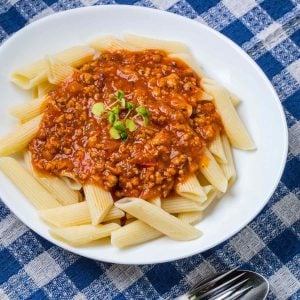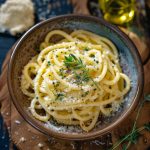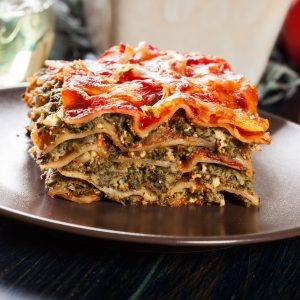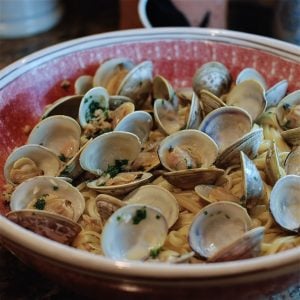Pici, A Classic Tuscan Pasta
While in Tuscany on vacation, we enjoyed pici at several restaurants. We even took a cooking class at Podere Il Casale, a farm located on the hilltop of the renowned Sienese countryside, where we made our pici pasta and then enjoyed it with a simple tomato sauce. We also learned how to prepare.
What is pici pasta?
Pici pasta, also known as “pici senesi,” is a traditional Italian variety from the picturesque region of Tuscany. With its origins dating back centuries, pici has become a beloved staple in Tuscan cuisine and has gained popularity worldwide for its rustic charm and unique texture.
Pici pasta has gained recognition outside of Italy, appearing on menus in various international restaurants. Its artisanal nature and rustic charm have appealed to food enthusiasts and chefs alike, who appreciate the authenticity and unique character it brings to a dish. Whether served with traditional Tuscan sauces or innovative combinations, pici continues to captivate diners with its toothsome texture and ability to hold robust flavors.
It is a cherished culinary gem from Tuscany, renowned for its handmade charm and distinctively chewy texture. Its simplicity and versatility have made it a beloved dish in Italy and beyond. Whether you enjoy it with a traditional Tuscan sauce or experiment with creative pairings, pici pasta is a delightful representation of the rich culinary heritage of the Tuscan region.
History
The history of pici pasta is deeply rooted in the culinary traditions of Tuscany, Italy. While the exact origins of this pasta variety are not well-documented, it is believed to have a long history dating back several centuries.
Pici is often associated with the province of Siena in Tuscany, and it is commonly referred to as “pici senesi” or “pici all’etrusca.” The Etruscans, an ancient civilization that inhabited central Italy before the Roman era, are believed to have influenced the development of pici. The Etruscans were known for their cultivation of grains and the production of handmade pasta, and their techniques and recipes likely shaped the early versions of pici.
The simplicity of pici can be attributed to the humble ingredients used in its preparation. Flour and water, the essential components of pici dough, have been available staples in Italian cuisine for centuries. The absence of eggs in the dough is also a characteristic that distinguishes pici from other pasta varieties, as eggs were traditionally scarce and more commonly used in northern Italian pasta recipes.
Pici’s hand-rolling technique has been passed down through generations, with each family and community putting their unique spin on the process. Rolling the dough by hand on wooden surfaces or boards has been preserved over time, contributing to the rustic and artisanal nature of pici pasta.
Originally, pici was a pasta that provided sustenance and nourishment to Tuscan farmers and locals. Its simplicity and the use of local ingredients made it an affordable and filling meal. The pasta was often enjoyed during the colder months when fresh produce was scarce, providing a hearty and comforting dish.
Today, pici is celebrated as a symbol of Tuscan culinary heritage and continues to be cherished for its artisanal qualities. It remains a staple in the region’s cuisine and is enjoyed in traditional and innovative preparations. Whether served in small trattorias in Tuscany or upscale Italian restaurants worldwide, pici pasta is a testament to Tuscan gastronomy’s enduring legacy.

Hand Rolling Pici
Pici is a hand-rolled pasta made simply from flour and water. Unlike other pasta shapes, it does not contain eggs, giving it a distinctive taste and texture. The dough is traditionally prepared by combining flour and water, forming a stiff mixture that is then kneaded for a prolonged period. This kneading process helps develop the gluten in the dough, resulting in a chewy and satisfyingly dense pasta.
Once the dough is ready, it is rolled into long, thick strands, resembling thick spaghetti or fat, irregular noodles. These strands are typically around 2-3 millimeters in diameter, though their thickness may vary slightly due to the hand-rolling process. The length of pici noodles can also differ, with some reaching up to 50 centimeters long.
The hand-rolling technique used to make pici pasta adds to its rustic appeal. It is a labor-intensive process, requiring skill and patience. Traditionally, the pasta is rolled by hand on a wooden board or countertop.
Cooks often use their palms to gently roll the dough, applying light pressure to elongate it and create the desired thickness. This artisanal touch gives pici its signature irregular shape, providing a delightful texture when cooked.
Sauces
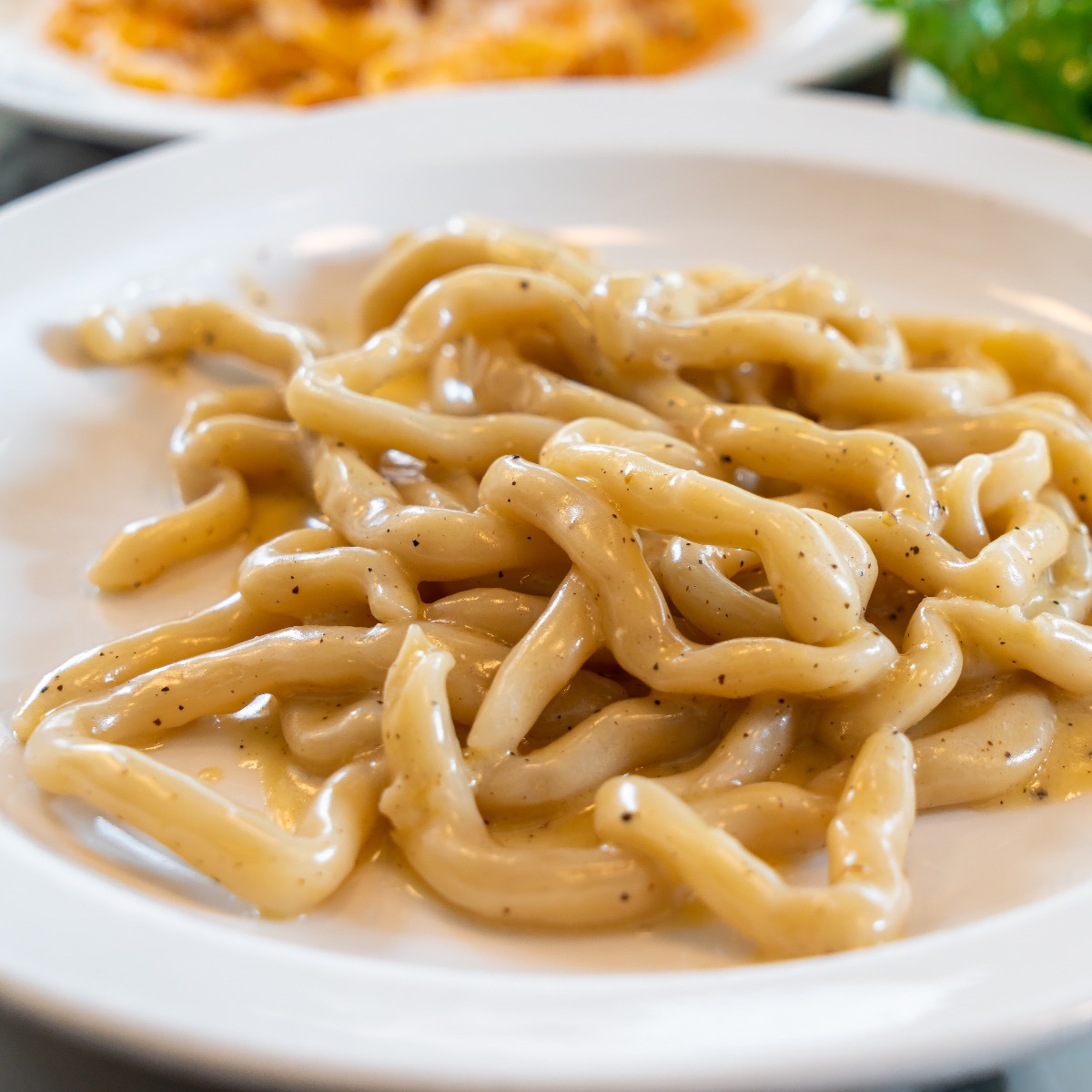
Pici pasta pairs well with various sauces, allowing for a range of flavors and textures to be enjoyed. Here are some delicious sauce options that complement the rustic charm and chewy texture of pici:
- Aglione: Aglione is a traditional Tuscan sauce made with garlic, tomatoes, chili peppers, and olive oil. Its vibrant flavors and simplicity make it an excellent choice for pici pasta. The sauce coats the noodles beautifully, absorbing the flavors while retaining the pasta’s chewy texture.
- Cacio e Pepe: Cacio e Pepe, meaning “cheese and pepper” in Italian, is a classic Roman sauce. Made with Pecorino Romano cheese and black pepper, it creates a creamy and flavorful coating for pici pasta. The sharpness of the cheese and the heat from the pepper combine to create a deliciously indulgent dish.
- Ragù: Pici’s chewy texture makes it an ideal match for hearty meat-based ragù sauces. Traditional Tuscan ragù often includes slow-cooked meats such as beef, pork, or game, along with aromatic vegetables and tomatoes. The pasta absorbs the rich flavors of the ragù, creating a comforting and satisfying meal.
- Pesto: Pici can be paired with various pesto sauces, such as the classic Genovese basil pesto, or other regional variations like walnut or sun-dried tomato pesto. The robust flavors and smooth texture of pesto provide a delightful contrast to the chewiness of pici pasta.
- Seafood Sauces: Pici also works well with seafood-based sauces. For example, a seafood marinara sauce featuring a medley of shrimp, clams, mussels, and calamari in a tomato and wine base can create a delightful combination with the pasta. The flavors of the seafood meld harmoniously with the pasta’s chewy texture.
- Mushroom Sauce: Pici pasta’s dense texture pairs excellently with earthy mushroom sauces. Sauteed mushrooms with garlic, herbs, and a touch of cream or white wine create a luscious sauce that clings to the noodles, offering a satisfying and flavorful experience.
5 Fun Facts about Pici
- Hand-rolled Pasta: Pici pasta is entirely handmade. Unlike most pasta varieties, it does not require any special tools or machines for its preparation. The pasta dough is rolled and elongated by hand, giving it a unique rustic appearance and texture.
- Ancient Origins: Pici has deep historical roots and is believed to have been influenced by the Etruscan civilization, which thrived in central Italy long before the Roman era. This makes pici one of the oldest forms of pasta in Italian culinary history.
- Variations in Shape and Size: Pici pasta is known for its irregular thickness and length. While it is typically thick and long, the size and shape of pici noodles can vary depending on the cook’s technique and preference. Some strands may be thicker or thinner, and lengths can range from a few centimeters to up to half a meter.
- Absence of Eggs: Traditional pici pasta does not contain eggs in its dough. Instead, it is made from a simple mixture of flour and water. This ingredient combination results in denser and chewier pasta than egg-based pasta varieties.
- Versatility in Pairings: Pici pasta is incredibly versatile regarding sauce pairings. While it is commonly enjoyed with Tuscan classics like aglione (garlic and tomato sauce) or cacio e pepe (cheese and pepper sauce), it can be combined with various flavors. Pici’s thick and chewy texture makes it perfect for clinging to robust sauces or absorbing rich flavors in ragù or seafood preparations.


Pici Pasta
Ingredients
- 2 cups all-purpose flour extra for dusting
- ½ teaspoon salt
- ⅔ cup water
- ¼ cup olive oil extra-virgin
- 4 cloves garlic minced
- ¼ teaspoon red pepper flakes
- salt and freshly ground pepper
- Parmesan cheese freshly grated, for serving
Instructions
- In a large mixing bowl, whisk together the flour and salt. Add the water and mix until a dough forms. Knead the dough for 5-7 minutes until it is smooth and elastic.
- Cover the dough with plastic wrap and let it rest at room temperature for 30 minutes.
- Divide the dough into four pieces. Roll each piece into a long, thin rope about 1/4 inch in diameter. Cut the ropes into 8-inch lengths.
- Using your hands, roll each length of dough into a thick, cylindrical shape, about 1/4 inch in diameter. Repeat with the remaining dough.
- Bring a large pot of salted water to a boil. Add the pici pasta and cook for 6-8 minutes, until al dente.
- While the pasta is cooking, heat the olive oil in a large skillet over medium heat. Add the garlic and red pepper flakes and cook for 1-2 minutes, until fragrant.
- Drain the pasta and add it to the skillet with the garlic and oil. Toss to coat the pasta with the sauce—season with salt and pepper to taste.
- Serve the pici pasta hot, with freshly grated Parmesan cheese on top. Enjoy!


